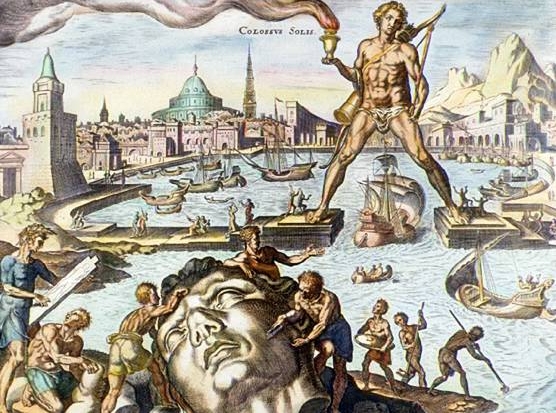(Someone on the Golden Book editorial staff must've had a classical background--there were tons of articles on various Greek and Roman figures, including one of Diogenes with his lamp. I clearly remember the entry on Damocles, looking up to see the sword hanging above his head.)
(From memory--I promise!)
- The Statue of Zeus
- The Colossus of Rhodes
- The Alexandria Lighthouse
- The Mausoleum
- The Hanging Gardens of Babylon
- The Temple at Ephesus
- The Pyramids at Giza
When I was a child, my favorite Wonders were the statue of Zeus and the Colossus--I think I probably thought of them as huge dolls and then their glamour, what with all that gold and precious gems, fascinated me as well. Just imagine sailing across the Aegean Sea and seeing that flash in the distance, the light shining off that enormous golden figure, standing against the sun. Helios, incarnate, towering over the people of Rhodes. The sad thing is, the Colossus only lasted 56 years before an earthquake destroyed it. Not quite three generations grew up in its shadow, basking in its protective glory--and then an earthquake toppled their patron and its fragments were scattered about the harbor.
Two vast and trunkless legs…
Half sunk, a shattered visage lies...
The earthquake happened in the 3rd century BC--and for the next 800 years, people from all over the Mediterranean, including Pliny the Elder and Strabo, came to marvel at the remains. The Rhodesians wouldn't rebuild; they were afraid the earthquake* was a sign they'd offended their sun god. And so he lay there in the harbor for 800 years. The Colossus was the shortest-lived of the Wonders--but perhaps no other has so seized the popular imagination... albeit in error! Though typically pictured standing, as Emma Lazarus put it,
With conquering limbs astride from land to land
The Colossus was NOT in fact built standing astride the entrance; the statue was either standing beside or overlooking the harbor. For one thing Rhodes would've had to have closed down the > harbor during construction (which was obviously economically unfeasible) but more importantly, engineering technology at that point was not advanced enough to build such a statue. And so Maarten van Heemskerck's lovely, detailed, hand-painted 16th century illustration
is imaginative rather than accurate. An image of genius indeed--Shakespeare references this Colossus at least three times, most notably in Julius Caesar who is described as a man who
...doth bestride the narrow world
Like a Colossus, and we petty men
Walk under his huge legs and peep about...
Three different eras are telescoped into one in this passage--Shakespeare's time toward the end of Elizabeth I's reign (ca. 1599), the last year of Julius Caesar's life (44 BC), and finally some two hundred years before, when the Colossus was still standing. Each with their particular set of attitudes, expectations, connotations, unspoken associations...and the picture of that bronze statue burning gloriously through them all, still evocative.
And as Lazarus's poem title ("The New Colossus") indicates, the Statue of Liberty was an homage to the Rhodes Helios. Both pedestalled metal statues, both facing east (like cathedrals, in fact, now that I think of it!), both invoking light, both as monuments to Liberty and Freedom (the Helios was built in thanksgiving for Rhodes having resisted invasion during the chaotic period after the death of Alexander the Great). Lady Liberty is wearing considerably more clothing than the Colossus is usually portrayed, however! Well, I suppose Rhodes is hotter than New York City.
Here in our sea-washed sunset** gates shall stand
A mighty woman with a torch, whose flame
Is the imprisoned lightning and her name
Mother of Exiles...
*The Rhodesians needn't have felt singled out--this being the Mediterranean, most of the seven Wonders were done in by earthquakes eventually
**Since Liberty faces east, this is an odd note.
Next, Part II: Nebuchadnezzar landscapes his city within an inch of its life, all to get some sugar.


FIRST!!!! (Pant Pant)
ReplyDelete*pats head* Good boy! :)
ReplyDeleteI think I had the same Golden Book Encyclopedias. Loved the sword of Damocles. My favorite wonder was the Hanging Gardens of Babylon, although the Colossus was second. Naturally, the library of Alexandria was the ancient place I would most have liked to visit, but I would have hit the lighthouse, too. Might as well see the pyramids while I was there, but only if Cleo would lend me her barge!
ReplyDeleteAs you can discern, my next entry on the Wonders will be about the Gardens, which is my current favorite. And the library! Don't get me started. Have you ever seen/read the play Arcadia? One of the main characters, in the 19th century, weeps at the loss of the library.
ReplyDelete